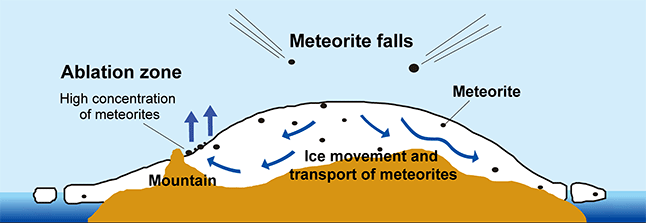About Antarctic Meteorite

Antarctic Meteorites
Since the discovery of the Yamato meteorite in 1969, more than 48,500 meteorites have been recovered from the Antarctic ice sheet. About 60% of the meteorites registered with the Meteoritical Society are collected from Antarctica, and Antarctica is considered to be the area on Earth where the largest number of meteorites are collected.
Mechanism of Meteorite Accumulation in Antarctica
Antarctic meteorites are often found in the ice sheets surrounding the interior mountain ranges. In these special zones near the Interior Mountains, there are exposed ice sheets with no snow on the surface, known scientifically as "blue ice areas." These ice sheets are the result of the compression of snow over a long period of time. Generally, these ice sheets flow gradually from the interior to the coast. This dynamic process is believed to have had a marked influence on the discovery and recovery of Antarctic meteorites.

Mechanism of Meteorite Accumulation in Antarctica
Meteorites that fall in Antarctica are incorporated into the surface snow. As snow accumulates, they become buried and, alongside the compaction of the snow, they get incorporated into the ice sheet, slowly flowing towards deeper areas or the coast along with the ice flow.
In mountainous regions, the ice sheet is halted, creating localized upwelling currents. Moreover, these regions experience strong "katabatic winds," causing the elevated ice to continuously sublime. Consequently, only the meteorites incorporated into the ice sheet are left behind.
As described above, a model for the accumulation mechanism of Antarctic meteorites has been proposed.



